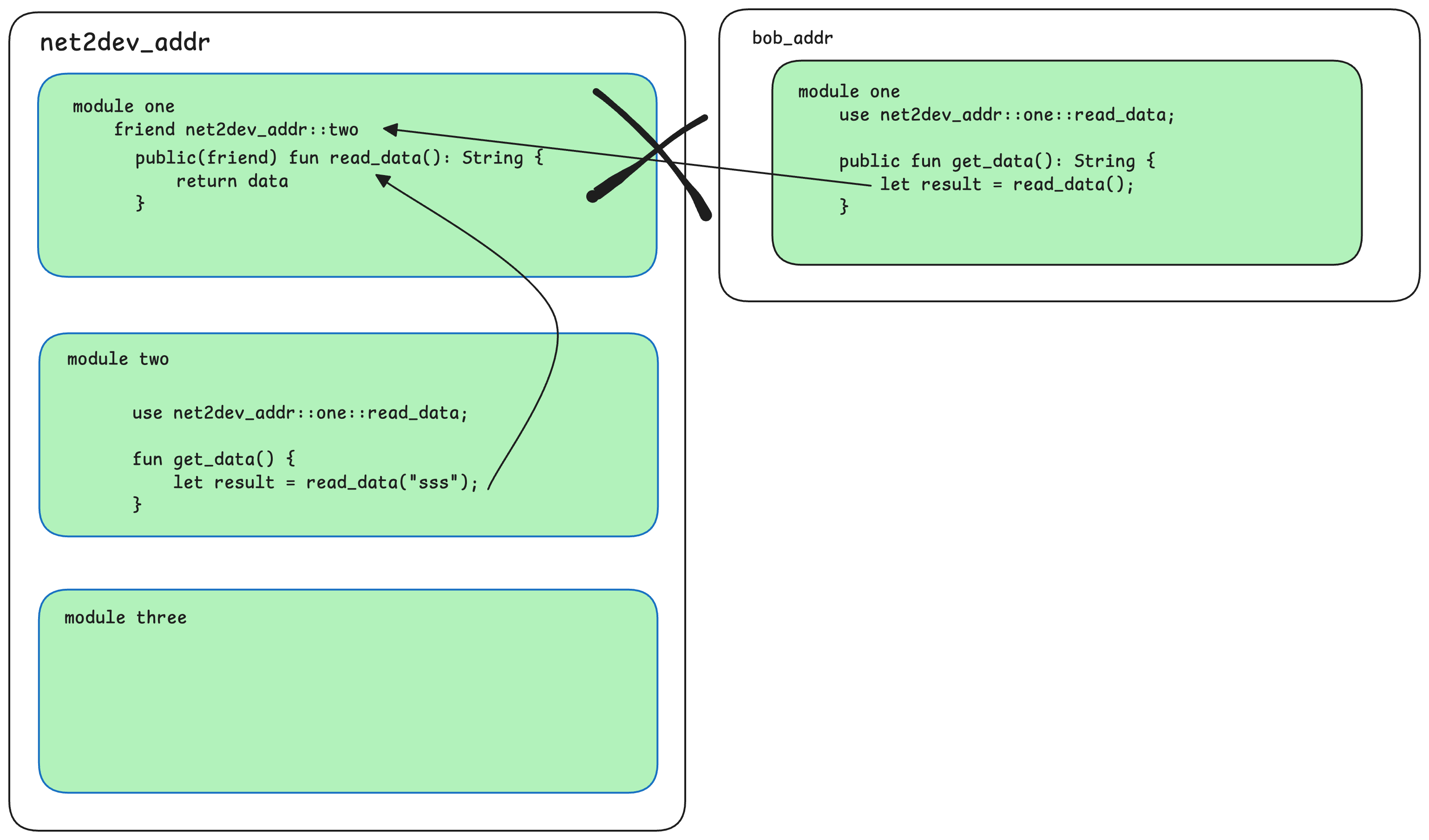Aptos
深入 Aptos Move:从public到friend,函数可见性详解
- 寻月隐君
- 发布于 2025-08-27 11:14
- 阅读 708
深入AptosMove:从public到friend,函数可见性详解在AptosMove智能合约开发中,精准控制函数的可见性是保障安全与效率的基石。然而,public、public(friend)与[view]之间的细微差别,以及它们对权限和Gas消耗的影响,常常让开发者感到
深入 Aptos Move:从public到friend,函数可见性详解
在 Aptos Move 智能合约开发中,精准控制函数的可见性是保障安全与效率的基石。然而,public、public(friend) 与 #[view] 之间的细微差别,以及它们对权限和 Gas 消耗的影响,常常让开发者感到困惑。本文将通过四个层层递进的代码实战和详尽的测试结果,带你从最基础的 public 函数出发,逐步深入 friend 机制的私有访问控制,并最终解析 #[view] 函数在零 Gas 查询中的应用。通过本教程,你将清晰地掌握 Move 语言的访问权限体系,为构建更健壮的智能合约打下坚实基础。
实操

示例一
address net2dev_addr {
module one {
public fun get_value(): u64 {
return 100
}
}
module two {
#[test_only]
use std::debug::print;
#[test]
fun test_function() {
let result = net2dev_addr::one::get_value();
print(&result);
assert!(result == 100, 0);
}
}
module three {
#[test_only]
use std::debug::print;
#[test]
fun test_function() {
let result = net2dev_addr::one::get_value();
print(&result);
assert!(result == 100, 0);
}
}
}
这段 Aptos Move 代码在 net2dev_addr 地址下定义了三个独立的模块。one 模块提供了一个简单的公共函数 get_value,它总是返回数值 100。two 模块和 three 模块是两个完全相同的测试模块,它们唯一的目的就是调用 one 模块的 get_value 函数,然后使用 assert! 断言来验证返回的结果是否确实等于 100。这整体上展示了在同一个地址空间内,不同模块之间如何进行函数调用,并通过单元测试来确保代码逻辑的正确性。
测试
➜ aptos move test
INCLUDING DEPENDENCY AptosFramework
INCLUDING DEPENDENCY AptosStdlib
INCLUDING DEPENDENCY MoveStdlib
BUILDING my-dapp
Running Move unit tests
[debug] 100
[debug] 100
[ PASS ] 0x48daaa7d16f1a59929ece03157b8f3e4625bc0a201988ac6fea9b38f50db5ef3::three::test_function
[ PASS ] 0x48daaa7d16f1a59929ece03157b8f3e4625bc0a201988ac6fea9b38f50db5ef3::two::test_function
Test result: OK. Total tests: 2; passed: 2; failed: 0
{
"Result": "Success"
}这个测试结果表明你的 Aptos Move 代码已经成功通过了所有的单元测试。测试框架首先编译了名为 my-dapp 的项目,然后分别执行了 three 模块和 two 模块中的 test_function 测试函数。日志中的两条 [debug] 100 信息证明了这两个测试都成功调用了 one 模块的函数并获取到了返回值 100。最终,[ PASS ] 状态和 passed: 2; failed: 0 的总结明确地显示,这两个测试函数中的 assert 断言都得到了满足,整个测试套件(包含两个测试用例)成功执行完毕,没有任何失败。
示例二
address net2dev_addr {
module one {
friend net2dev_addr::two;
public(friend) fun get_value(): u64 {
return 100
}
}
module two {
#[test_only]
use std::debug::print;
#[test]
fun test_function() {
let result = net2dev_addr::one::get_value();
print(&result);
assert!(result == 100, 0);
}
}
module three {
#[test_only]
use std::debug::print;
#[test]
fun test_function() {
let result = net2dev_addr::one::get_value();
print(&result);
assert!(result == 100, 0);
}
}
}
这段 Aptos Move 代码核心展示了 friend (友元)可见性机制,用于在模块间实现受控的私有访问。one 模块中的 get_value 函数被声明为 public(friend),这意味着它不再对所有模块公开,而是仅对被 one 模块明确声明为 friend 的模块可见。代码中,one 模块只将 two 模块指定为其友元,因此 two 模块的测试函数可以合法地调用 get_value。然而,three 模块并未被声明为友元,所以它尝试调用 get_value 的行为是不被允许的,这将导致编译时发生可见性错误。这整体上演示了如何使用 friend 功能来创建更严格的模块边界,只在必要时向特定的、受信任的模块暴露内部函数。
测试
➜ aptos move test
INCLUDING DEPENDENCY AptosFramework
INCLUDING DEPENDENCY AptosStdlib
INCLUDING DEPENDENCY MoveStdlib
BUILDING my-dapp
error: function `0x48daaa7d16f1a59929ece03157b8f3e4625bc0a201988ac6fea9b38f50db5ef3::one::get_value` cannot be called from function `0x48daaa7d16f1a59929ece03157b8f3e4625bc0a201988ac6fea9b38f50db5ef3::three::test_function` because module `0x48daaa7d16f1a59929ece03157b8f3e4625bc0a201988ac6fea9b38f50db5ef3::three` is not a `friend` of `0x48daaa7d16f1a59929ece03157b8f3e4625bc0a201988ac6fea9b38f50db5ef3::one`
┌─ /Users/qiaopengjun/Code/Aptos/move-tut/sources/sample3.move:5:24
│
5 │ public(friend) fun get_value(): u64 {
│ ^^^^^^^^^ callee
·
27 │ let result = net2dev_addr::one::get_value();
│ ------------------------------ called here
{
"Error": "Unexpected error: Failed to run tests: exiting with env checking errors"
}
这个测试结果显示编译失败,而不是测试运行后的失败。错误信息明确指出,three 模块中的 test_function 尝试调用 one 模块的 get_value 函数,但这个调用被拒绝了。原因是 get_value 函数被声明为 public(friend),只对 one 模块的友元(friend)可见,而 three 模块并没有被声明为友元。因此,由于违反了 friend 可见性规则,代码在静态检查阶段就无法通过,导致整个测试流程因编译环境检查错误而提前中止,没有任何一个测试被实际运行。
示例三
address net2dev_addr {
module one {
friend net2dev_addr::two;
friend net2dev_addr::three;
public(friend) fun get_value(): u64 {
return 100
}
}
module two {
#[test_only]
use std::debug::print;
#[test]
fun test_function() {
let result = net2dev_addr::one::get_value();
print(&result);
assert!(result == 100, 0);
}
}
module three {
#[test_only]
use std::debug::print;
#[test]
fun test_function() {
let result = net2dev_addr::one::get_value();
print(&result);
assert!(result == 100, 0);
}
}
}
这段 Aptos Move 代码是对之前版本的修正,核心变化在于 one 模块现在同时将 two 模块和 three 模块都声明为了自己的 friend (友元)。这个改动使得 one 模块中 public(friend) 可见性的 get_value 函数,现在对 two 和 three 模块均开放了访问权限。因此,之前会导致编译错误的 three 模块调用 get_value 的行为现在变得完全合法。最终,这段代码将能够成功编译,并且其包含的两个单元测试都会顺利运行并通过,展示了如何通过友元列表向多个特定的、受信任的模块安全地开放内部功能。
测试
➜ aptos move test
INCLUDING DEPENDENCY AptosFramework
INCLUDING DEPENDENCY AptosStdlib
INCLUDING DEPENDENCY MoveStdlib
BUILDING my-dapp
Running Move unit tests
[debug] 100
[debug] 100
[ PASS ] 0x48daaa7d16f1a59929ece03157b8f3e4625bc0a201988ac6fea9b38f50db5ef3::three::test_function
[ PASS ] 0x48daaa7d16f1a59929ece03157b8f3e4625bc0a201988ac6fea9b38f50db5ef3::two::test_function
Test result: OK. Total tests: 2; passed: 2; failed: 0
{
"Result": "Success"
}这个测试结果表明,在你将 three 模块也添加为 one 模块的友元(friend)后,代码已能成功编译并通过所有测试。测试框架运行了 two 模块和 three 模块中的测试函数,两条 [debug] 100 日志证明了现在这两个模块都可以合法地调用 get_value 函数并正确获取到返回值 100。最终 [ PASS ] 的状态和 passed: 2; failed: 0 的总结确认了两个测试用例中的 assert 断言均已满足,从而验证了 friend 机制的修改已按预期生效。
示例四
address net2dev_addr {
module one {
friend net2dev_addr::two;
friend net2dev_addr::three;
public(friend) fun get_value(): u64 {
return 100
}
#[view]
public fun get_price(): u64 {
return 42
}
}
module two {
#[test_only]
use std::debug::print;
#[test]
fun test_function() {
let result = net2dev_addr::one::get_value();
print(&result);
assert!(result == 100, 0);
}
#[test]
fun test_view() {
let result = net2dev_addr::one::get_price();
print(&result);
assert!(result == 42, 0);
}
}
module three {
#[test_only]
use std::debug::print;
#[test]
fun test_function() {
let result = net2dev_addr::one::get_value();
print(&result);
assert!(result == 100, 0);
}
#[test]
fun test_view() {
let result = net2dev_addr::one::get_price();
print(&result);
assert!(result == 42, 0);
}
}
}
这段 Aptos Move 代码在 one 模块中新增了一个带有 #[view] 属性的公共函数 get_price,它返回数值 42。#[view] 属性表明这是一个只读函数,调用它不会产生链上交易或消耗 Gas 费,因此可以被任何外部客户端或模块安全地用来查询数据。与此同时,get_value 函数仍然保持 public(friend) 的私有可见性,仅对友元模块 two 和 three 开放。因此,two 和 three 模块现在都新增了一个名为 test_view 的测试,用于验证它们既能调用私有的友元函数 get_value,也能调用完全公开的视图函数 get_price,展示了 Move 语言中不同函数可见性和功能的组合使用。
测试
➜ aptos move test
INCLUDING DEPENDENCY AptosFramework
INCLUDING DEPENDENCY AptosStdlib
INCLUDING DEPENDENCY MoveStdlib
BUILDING my-dapp
Running Move unit tests
[debug] 100
[debug] 100
[ PASS ] 0x48daaa7d16f1a59929ece03157b8f3e4625bc0a201988ac6fea9b38f50db5ef3::two::test_function
[ PASS ] 0x48daaa7d16f1a59929ece03157b8f3e4625bc0a201988ac6fea9b38f50db5ef3::three::test_function
[debug] 42
[debug] 42
[ PASS ] 0x48daaa7d16f1a59929ece03157b8f3e4625bc0a201988ac6fea9b38f50db5ef3::three::test_view
[ PASS ] 0x48daaa7d16f1a59929ece03157b8f3e4625bc0a201988ac6fea9b38f50db5ef3::two::test_view
Test result: OK. Total tests: 4; passed: 4; failed: 0
{
"Result": "Success"
}这个测试结果显示你的项目已成功通过全部四个单元测试。测试框架首先运行了验证友元函数 get_value 的两个测试 (test_function),从 [debug] 100 日志可以看出它们都成功获取了返回值 100。接着,框架又运行了验证视图函数 get_price 的两个新测试 (test_view),[debug] 42 的日志证明了它们也正确获取了返回值 42。最终 passed: 4; failed: 0 的总结表明,无论是受限访问的友元函数还是公开的视图函数,其功能都已按预期通过了验证。
总结
通过这四个实战示例的演进,我们完整地探索了 Aptos Move 中函数可见性的核心机制。我们从最简单的 public 函数出发,理解了模块间的基础通信;接着,通过引入 public(friend),我们掌握了如何在受信任的模块之间建立私有的“朋友圈”,并亲眼见证了非友元模块访问失败的编译时保护,这对于构建安全的内部逻辑至关重要;最后,我们引入了 #[view] 函数,明确了它作为“官方只读”声明在实现零 Gas 外部查询中的关键作用。
掌握这些可见性规则,不仅仅是学会了 Move 的语法,更是掌握了构建安全、高效、低成本智能合约的基石。希望这次的实操讲解能为你扫清障碍,让你在 Aptos 生态的开发之路上走得更稳、更远。
参考
- https://dorahacks.io/hackathon/aptos-ctrlmove-hackathon/detail
- https://github.com/aptos-labs
- https://learn.aptoslabs.com/en/code-examples
